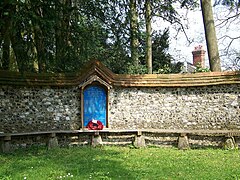Wilsford cum Lake
| Wilsford cum Lake | |
|---|---|
 War Memorial, Wilsford |
|
| Wilsford cum Lake shown within Wiltshire | |
| Population | 191 (in 2011) |
| OS grid reference | SU135398 |
| Civil parish |
|
| Unitary authority | |
| Ceremonial county | |
| Region | |
| Country | England |
| Sovereign state | United Kingdom |
| Post town | Salisbury |
| Postcode district | SP4 |
| Dialling code | 01980 |
| Police | Wiltshire |
| Fire | Dorset and Wiltshire |
| Ambulance | South Western |
| EU Parliament | South West England |
| UK Parliament | |
Wilsford cum Lake is a civil parish in the Woodford valley in Wiltshire, England. The parish is bounded to the east by the Salisbury Avon and contains the small settlements of Wilsford, Normanton and Lake. Wilsford is about 2 miles (3.2 km) southwest of Amesbury and 6 miles (10 km) north of Salisbury.
The parish is rich in archaeological features, and lies within the Stonehenge World Heritage Site. The scheduled monuments at Normanton Down include a Neolithic long barrow and some 40 Bronze Age round barrows.
Three estates were recorded in the Domesday Book of 1086, with 19 households. A chapel at Lake belonged to Bradenstoke Priory in the early 12th century; it fell into disuse before the 16th century. By the early 13th century, the two adjacent church parishes of Wilsford and Woodford supported a prebendary at Salisbury.
A small Church of England school was built at Wilsford in 1857, extended in 1915 and closed in 1960.
Normanton was transferred from Durnford to the parish in 1885.
The parish church of St Michael is from the 12th century but was largely rebuilt in 1852 by T.H. Wyatt. Wall monuments inside the church include an engraved slate tablet by Eric Gill. The church was designated as Grade II* listed in 1958.
Wilsford House, near the church, is also Grade II* listed. The house was built in 17th-century style by Detmar Blow in 1904-6 for Sir Edward Tennant, a Scottish politician who was Member of Parliament for Salisbury from 1906 to 1910. The house was inherited by Sir Edward's son, Stephen Tennant, a leading member of the "Bright young things" social set. Author V. S. Naipaul rented a cottage in the grounds and much of his 1987 novel The Enigma of Arrival is based on the surrounding area.
...
Wikipedia

